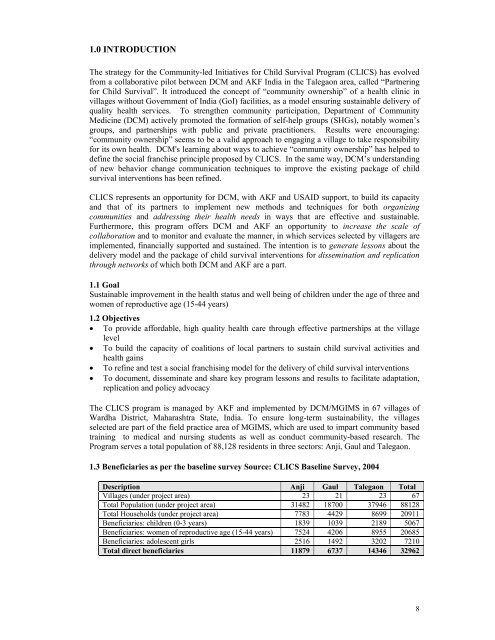community led initiatives for child survival program ? (clics) - Nipccd
community led initiatives for child survival program ? (clics) - Nipccd
community led initiatives for child survival program ? (clics) - Nipccd
You also want an ePaper? Increase the reach of your titles
YUMPU automatically turns print PDFs into web optimized ePapers that Google loves.
1.0 INTRODUCTION<br />
The strategy <strong>for</strong> the Community-<strong>led</strong> Initiatives <strong>for</strong> Child Survival Program (CLICS) has evolved<br />
from a collaborative pilot between DCM and AKF India in the Talegaon area, cal<strong>led</strong> “Partnering<br />
<strong>for</strong> Child Survival”. It introduced the concept of “<strong>community</strong> ownership” of a health clinic in<br />
villages without Government of India (GoI) facilities, as a model ensuring sustainable delivery of<br />
quality health services. To strengthen <strong>community</strong> participation, Department of Community<br />
Medicine (DCM) actively promoted the <strong>for</strong>mation of self-help groups (SHGs), notably women’s<br />
groups, and partnerships with public and private practitioners. Results were encouraging:<br />
“<strong>community</strong> ownership” seems to be a valid approach to engaging a village to take responsibility<br />
<strong>for</strong> its own health. DCM's learning about ways to achieve “<strong>community</strong> ownership” has helped to<br />
define the social franchise principle proposed by CLICS. In the same way, DCM’s understanding<br />
of new behavior change communication techniques to improve the existing package of <strong>child</strong><br />
<strong>survival</strong> interventions has been refined.<br />
CLICS represents an opportunity <strong>for</strong> DCM, with AKF and USAID support, to build its capacity<br />
and that of its partners to implement new methods and techniques <strong>for</strong> both organizing<br />
communities and addressing their health needs in ways that are effective and sustainable.<br />
Furthermore, this <strong>program</strong> offers DCM and AKF an opportunity to increase the scale of<br />
collaboration and to monitor and evaluate the manner, in which services selected by villagers are<br />
implemented, financially supported and sustained. The intention is to generate lessons about the<br />
delivery model and the package of <strong>child</strong> <strong>survival</strong> interventions <strong>for</strong> dissemination and replication<br />
through networks of which both DCM and AKF are a part.<br />
1.1 Goal<br />
Sustainable improvement in the health status and well being of <strong>child</strong>ren under the age of three and<br />
women of reproductive age (15-44 years)<br />
1.2 Objectives<br />
• To provide af<strong>for</strong>dable, high quality health care through effective partnerships at the village<br />
level<br />
• To build the capacity of coalitions of local partners to sustain <strong>child</strong> <strong>survival</strong> activities and<br />
health gains<br />
• To refine and test a social franchising model <strong>for</strong> the delivery of <strong>child</strong> <strong>survival</strong> interventions<br />
• To document, disseminate and share key <strong>program</strong> lessons and results to facilitate adaptation,<br />
replication and policy advocacy<br />
The CLICS <strong>program</strong> is managed by AKF and implemented by DCM/MGIMS in 67 villages of<br />
Wardha District, Maharashtra State, India. To ensure long-term sustainability, the villages<br />
selected are part of the field practice area of MGIMS, which are used to impart <strong>community</strong> based<br />
training to medical and nursing students as well as conduct <strong>community</strong>-based research. The<br />
Program serves a total population of 88,128 residents in three sectors: Anji, Gaul and Talegaon.<br />
1.3 Beneficiaries as per the baseline survey Source: CLICS Baseline Survey, 2004<br />
Description Anji Gaul Talegaon Total<br />
Villages (under project area) 23 21 23 67<br />
Total Population (under project area) 31482 18700 37946 88128<br />
Total Households (under project area) 7783 4429 8699 20911<br />
Beneficiaries: <strong>child</strong>ren (0-3 years) 1839 1039 2189 5067<br />
Beneficiaries: women of reproductive age (15-44 years) 7524 4206 8955 20685<br />
Beneficiaries: adolescent girls 2516 1492 3202 7210<br />
Total direct beneficiaries 11879 6737 14346 32962<br />
8
















